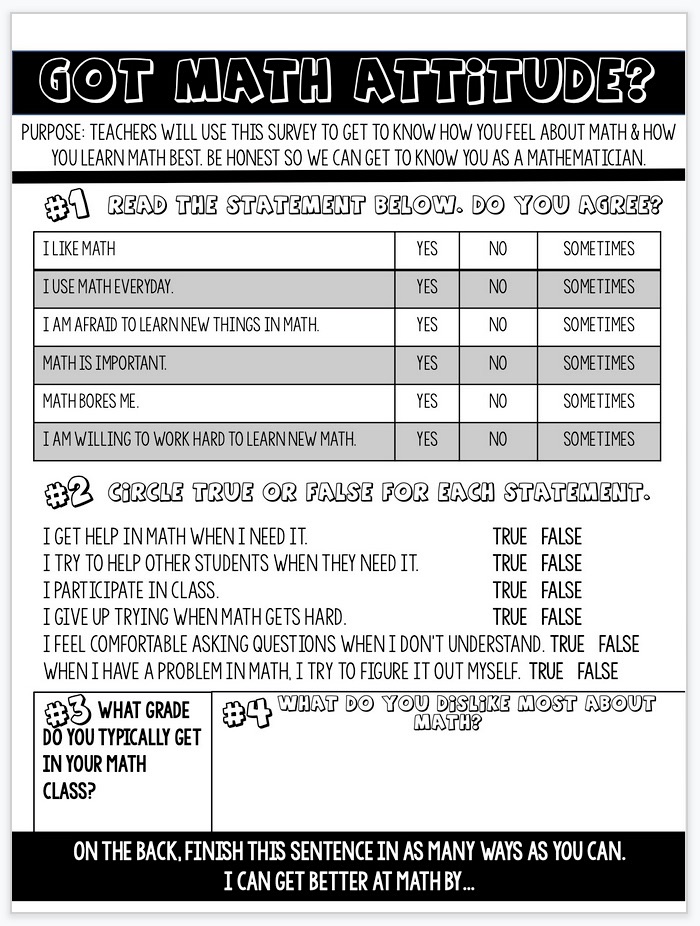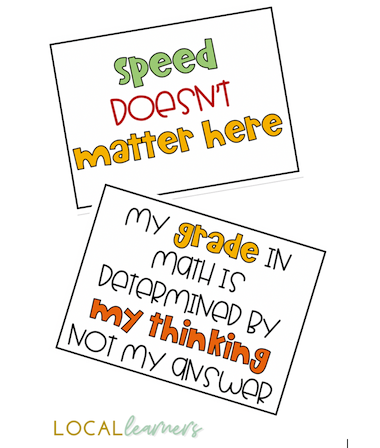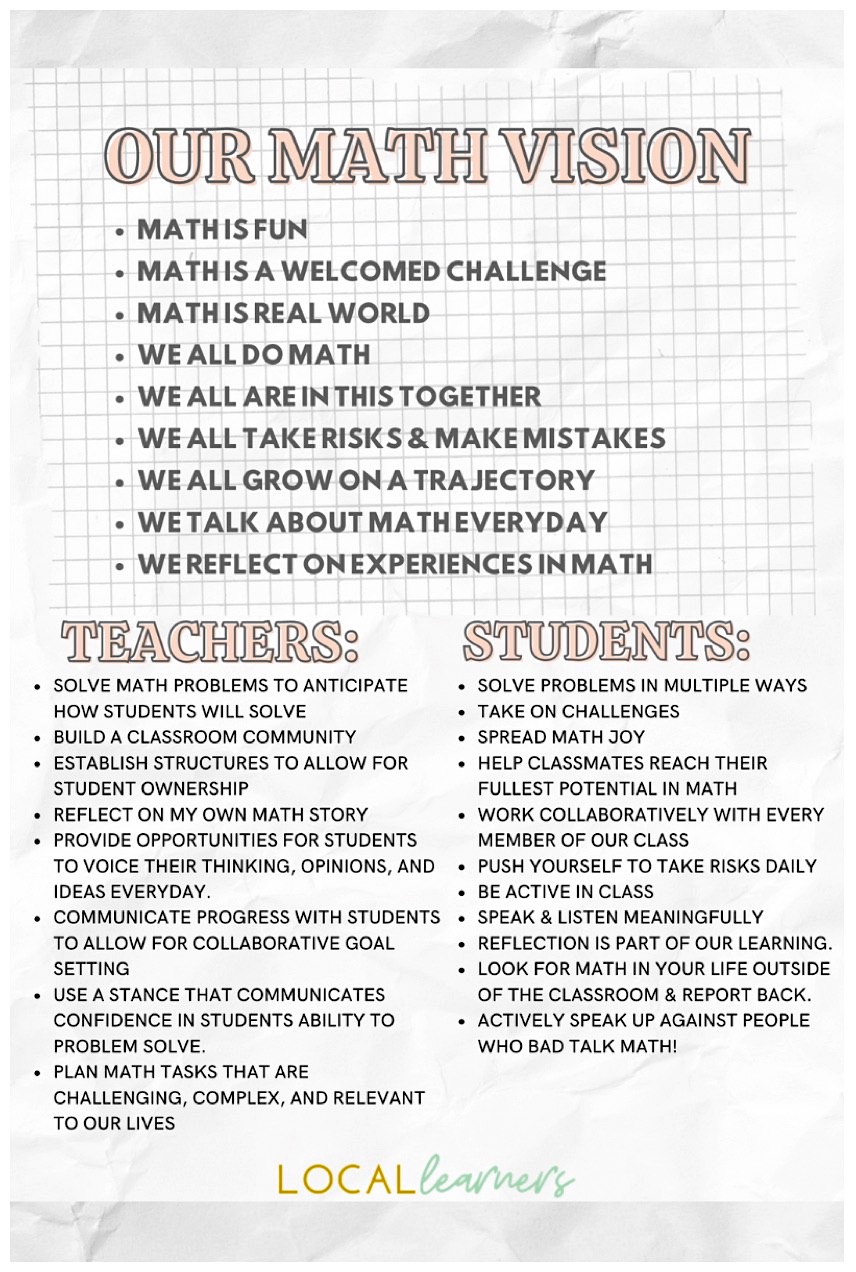4 Moves to Help Tweens Overcome Math Anxiety
This school year Chicago teacher Mona Iehl is writing a series about teaching mathematics in the middle grades (5-8) for MiddleWeb. We learned about Mona’s work last spring when she contributed a video-enriched post about her pandemic teaching strategies. In her first post of the new series she focuses on creating a strong classroom culture.
 By Mona Iehl
By Mona Iehl
A classroom community is something I work on all year long. At the beginning of the year I pay particular attention to laying the foundation that our middle grades community will stand on throughout the months to come.
Math class brings certain challenges and requires special attention when forming a community. Many of my students enter my math class with negative math experiences and associations. My goal is that each student feels a sense of safety and belonging as we explore math together.
Part of creating that sense of belonging is making sure students feel seen, heard, and understood in our math community. With strong relationships and open communication we will push each other to reach expectations and goals we never dreamed possible.
What Do We Mean by Strong?
Let’s start by defining what makes a strong classroom community.
Creating common definitions is a practice I use when creating our classroom foundations. Involving my students in the creation of these common definitions helps them feel their opinions are valued and builds their investment in the community.
Take a moment to think to yourself about how you would describe a solid classroom community.
Here’s my list of what makes a community strong:
- Relationships with students and among students.
- Collaboration among students and adults to make sense of mathematics, solve complex problems, and support one another through challenges.
- Every classroom community feels like a safe and welcoming home. Students know they can share their whole self and take risks because the community is a safe place to do so.
- Every student is an equal member of the community and every voice is valued.
Building the Community Foundation
As we start the year I use these four activities to help establish our math classroom community.
► Math Attitude Survey
This is a simple, one page survey that allows students to communicate their experiences, interests, and hesitancy with math. A few things I ask on the survey include their willingness to ask for help and their homework routine at home.
Each question helps me understand them better as mathematicians and create classroom activities to address their current math mindsets. I use the data gathered from these surveys to fuel class conversations about how we want to form our math classroom.
For example, if I notice that many students “give up when math gets hard” then we might begin by focusing on Math Practice Standard #1: Make sense of problems and persevere in solving them. I use the information from the survey to help me plan lessons to address my students’ math mindset, executive functioning and work habits.
► Sharing Math Stories
Telling our math stories allows us to share our math identity with the community. A math identity is how students see themselves as mathematicians. We spend time at the start of the year reflecting on our past math experiences and drafting math stories. Then, students (and teacher) share their stories with the group.
Sharing our math stories helps us get to know one another in ways we may not ever have thought about. Students find affirmation in knowing that their classmates also feel intimidated by math or that others also secretly love homework.
Although it is challenging to be vulnerable and share your personal experiences of struggle, students find this experience helps them identify parts of their math past they want to overcome. Math stories also help me get to know the students better and in turn form better relationships with each of them.
► Establishing Math Norms
Norm creation is a must in math class. So often our students enter math with big feelings, and it is essential we ensure that safety is upheld. My students and I co-create norms for just about everything we do in math- independent work time, group work, homework, discussions, etc.
Norm creation happens in five simple steps:
- Describe the situation we are creating norms for.
- Brainstorm a list of how you want that time to go, ideally. Then brainstorm a list of how you don’t want that to go.
- Share your ideas with the group.
- Agree on the list of norms as a community.
- Commit to holding each other to following these norms.
This process of norm creation is even better when it directly follows an experience in which norms are needed. So I like to have my students work on a group challenge prior to forming norms. Then as we debrief the challenge and students start to point out some issues they faced while working in groups, it naturally leads us to a great discussion about needing the norms.
► Creating a Shared Math Vision
Creating a math vision is essential to keeping me focused on what really matters in my math classroom community. A math vision allows me to prioritize what I value and how I want my students to experience math in our classroom.
To create my math vision I create a list of 5 to 10 statements about my ideal math classroom. Then I develop actionable steps for both adults and students to help enact the vision. I like to get my students involved in creating the vision, as well. Typically we start the conversation with a prompt to dream up their ideal math class.
After partnerships or small groups have had a chance to dream big, they contribute their “ideal math class” ideas to a whole class anchor chart. The best part is when I look at them all *very serious and excited* and say, “This looks perfect!”
Usually they’re very confused and taken off guard, and students start yelling out things like: “Wait, are you serious?”, “No homework?”, “We can pick our own groups?”, etc. When I allow my students to create their ideal math class, the buy-in and motivation is unbeatable.
Obviously I always have those few comments that just aren’t ideal, but they make for a great conversation. For example, “I want easy problems with no challenge” allows us to talk about the joy we will find in complex problems this year and how challenges are the way we learn.
I Know It’s Hard – But Take the Time!
Every year it gets a bit more challenging to fend off the start of the curriculum and make the time to establish community. However, I know that when I lay a solid foundation and build sound walls, our math community can withstand a year of wild learning and any storm that comes our way.
Mona Iehl (@LocalLearnersandCo) is a fifth and sixth grade math teacher at Polaris Charter Academy in Chicago, Illinois. Mona started her career 14 years ago teaching in the primary grades at Polaris but found her home in the middle grades six years ago. Mona recently took her passion for helping teachers and students find their inner mathematician to the blog world, and you can visit her Local Learners website for more teaching ideas.





































There are many great ideas to help students enjoy learning math and set a positive classroom atmosphere for the year. Thanks for sharing. I have added them to my collection of “Its the First Days of School, What Am I going to do?” http://bit.ly/lennyvrelationship
My favorite saying is that “Students do not care what you know until they know you care.” I am sure that you have a strong classroom community who are finding the wonder, joy, and beauty of learning mathematics.
Fantastic ideas for creating a positive learning environment for math class. I fully believe that establishing a welcoming and safe environment for students promotes learning. Your approach to vision casting is both inviting and hilarious! It is a great way to see how students enjoy learning and still leave room for what makes good learning experiences.
I will definitely be sharing this with my teachers.
Thank you for your thoughts!